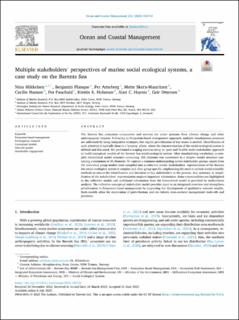| dc.contributor.author | Mikkelsen, Nina | |
| dc.contributor.author | Planque, Benjamin | |
| dc.contributor.author | Arneberg, Per | |
| dc.contributor.author | Skern-Mauritzen, Mette | |
| dc.contributor.author | Hansen, Cecilie | |
| dc.contributor.author | Fauchald, Per | |
| dc.contributor.author | Holsman, Kirstin K. | |
| dc.contributor.author | Haynie, Alan C. | |
| dc.contributor.author | Ottersen, Geir | |
| dc.coverage.spatial | Barents Sea, Barentshavet | en_US |
| dc.date.accessioned | 2023-10-04T12:54:35Z | |
| dc.date.available | 2023-10-04T12:54:35Z | |
| dc.date.created | 2023-09-05T10:57:36Z | |
| dc.date.issued | 2023 | |
| dc.identifier.citation | Ocean and Coastal Management. 2023, 242 . | en_US |
| dc.identifier.issn | 0964-5691 | |
| dc.identifier.uri | https://hdl.handle.net/11250/3094167 | |
| dc.description.abstract | The Barents Sea ecosystem components and services are under pressure from climate change and other
anthropogenic impacts. Following an Ecosystem-based management approach, multiple simultaneous pressures
are addressed by using integrative strategies, but regular prioritization of key issues is needed. Identification of
such priorities is typically done in a ‘scoping’ phase, where the characterization of the social-ecological system is
defined and discussed. We performed a scoping exercise using an open and flexible multi-stakeholder approach
to build conceptual models of the Barents Sea social-ecological system. After standardizing vocabulary, a com plex hierarchical model structure containing 155 elements was condensed to a simpler model structure con taining a maximum of 36 elements. To capture a common understanding across stakeholder groups, inputs from
the individual group models were compiled into a collective model. Stakeholders’ representation of the Barents
Sea social-ecological system is complex and often group specific, emphasizing the need to include social scientific
methods to ensure the identification and inclusion of key stakeholders in the process. Any summary or simpli fication of the stakeholders’ representation neglects important information. Some commonalities are highlighted
in the collective model, and additional information from the hierarchical model is provided by multicriteria
analysis. The collective conceptual stakeholder model provides input to an integrated overview and strengthens
prioritization in Ecosystem-based management by supporting the development of qualitative network models.
Such models allow for exploration of perturbations and can inform cross-sectoral management trade-offs and
priorities | en_US |
| dc.language.iso | eng | en_US |
| dc.rights | Navngivelse 4.0 Internasjonal | * |
| dc.rights.uri | http://creativecommons.org/licenses/by/4.0/deed.no | * |
| dc.subject | Ecosystem-based management | en_US |
| dc.subject | Participatory research | en_US |
| dc.subject | Conceptual models | en_US |
| dc.subject | Directed graphs | en_US |
| dc.subject | Stakeholder engagement | en_US |
| dc.title | Multiple stakeholders’ perspectives of marine social ecological systems, a case study on the Barents Sea | en_US |
| dc.title.alternative | Multiple stakeholders’ perspectives of marine social ecological systems, a case study on the Barents Sea | en_US |
| dc.type | Peer reviewed | en_US |
| dc.type | Journal article | en_US |
| dc.description.version | publishedVersion | en_US |
| dc.rights.holder | © 2023 The Authors | en_US |
| dc.source.pagenumber | 15 | en_US |
| dc.source.volume | 242 | en_US |
| dc.source.journal | Ocean and Coastal Management | en_US |
| dc.identifier.doi | 10.1016/j.ocecoaman.2023.106724 | |
| dc.identifier.cristin | 2172430 | |
| dc.relation.project | Norges forskningsråd: 288192 | en_US |
| dc.source.articlenumber | 106724 | en_US |
| cristin.ispublished | true | |
| cristin.fulltext | original | |
| cristin.qualitycode | 1 | |

